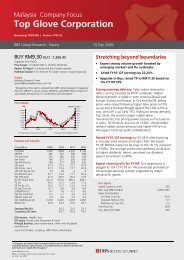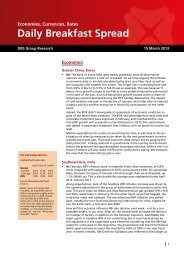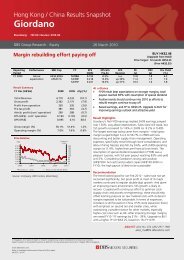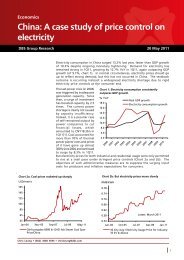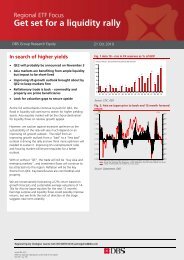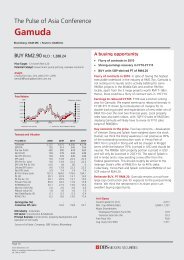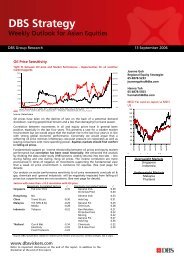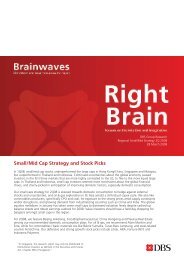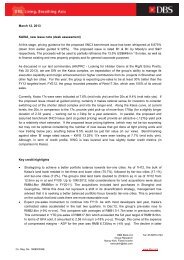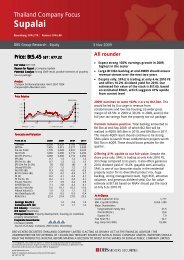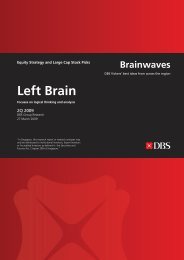Economics Markets Strategy - the DBS Vickers Securities Equities ...
Economics Markets Strategy - the DBS Vickers Securities Equities ...
Economics Markets Strategy - the DBS Vickers Securities Equities ...
You also want an ePaper? Increase the reach of your titles
YUMPU automatically turns print PDFs into web optimized ePapers that Google loves.
<strong>Economics</strong>: Malaysia<br />
<strong>Economics</strong> – <strong>Markets</strong> – <strong>Strategy</strong><br />
Bank Negara to<br />
hike <strong>the</strong> policy rate<br />
50bps in 3Q08, to<br />
4.0%<br />
Policy action needed<br />
Higher inflation will push real interest rates towards negative territory, if <strong>the</strong>y<br />
are not already <strong>the</strong>re (Chart 3). Adjusted for inflation, real deposit rates were at<br />
-1.63% in Apr08. Real policy rates and lending rates will most likely fall fur<strong>the</strong>r<br />
if inflation spikes to 5.8% in June on <strong>the</strong> fuel price hike. A negative real interest<br />
rate scenario favours borrowers, and risks fuelling asset inflation. As general<br />
prices rise, so could inflation expectations, resulting in even higher inflation<br />
going forward. For example, if workers demand higher wages in anticipation<br />
of fur<strong>the</strong>r price increases, it will inevitably set off a second round of price increase.<br />
Thus, policy action is needed now to anchor inflation expectations, and to prevent<br />
second-round inflationary effects. We expect Bank Negara to hike <strong>the</strong> policy<br />
rate by 50bps at <strong>the</strong> next policy meeting in July (Chart 2), taking <strong>the</strong> Overnight<br />
Policy Rate to 4%. In fact, while no policy meeting is planned for June, we do<br />
not discount <strong>the</strong> possibility of an inter-meeting hike. In addition, while <strong>the</strong><br />
inflationary effects of <strong>the</strong> fuel price hikes are expected to be transient and will<br />
likely wear off after 12 months, <strong>the</strong> government has hinted that this may just<br />
be <strong>the</strong> first of a string of subsidy cuts. Overall, inflationary pressure will remain<br />
high amid risks of higher global commodity prices and fur<strong>the</strong>r hikes in subsidized<br />
fuel prices. The central bank sounded hawkish in its most recent policy statement,<br />
and we believe <strong>the</strong> rhetoric will remain so in <strong>the</strong> next few quarters given <strong>the</strong><br />
outlook on inflation.<br />
Chart 3: Real interest rates heading south<br />
%, % pa<br />
6<br />
5<br />
4<br />
Real policy rate<br />
Real deposit rate<br />
Real lending rate<br />
3<br />
2<br />
1<br />
0<br />
-1<br />
-2<br />
-3<br />
-4<br />
Latest: Apr08<br />
Jan-05 Aug-05 Mar-06 Oct-06 May-07 Dec-07<br />
Chart 4: Growth likely to moderate<br />
%-pt contribution<br />
20<br />
15<br />
10<br />
5<br />
0<br />
-5<br />
-10<br />
Net exports<br />
Investment<br />
Govt expenditure<br />
Pvt consumption<br />
GDP growth<br />
Latest: 1Q08<br />
Mar-05 Mar-06 Mar-07 Mar-08<br />
Growth will be affected<br />
The impact on growth will be mixed. Although savings from <strong>the</strong> subsidies can<br />
be used to stimulate growth, we think that this is more likely to happen in <strong>the</strong><br />
longer term than in <strong>the</strong> near term. In fact, <strong>the</strong> government has not publicly<br />
explained how <strong>the</strong> savings from <strong>the</strong> subsidy cuts will be used. While we assume<br />
that effort will be put into upgrading <strong>the</strong> existing transport network, work will<br />
probably start at a later stage and benefits will only be reaped in <strong>the</strong> longer<br />
term.<br />
In <strong>the</strong> near term, domestic demand will be most affected by <strong>the</strong> fuel price hike.<br />
In particular, private consumption, which registered robust growth of 11.6%<br />
YoY and contributed 3.6%-pts to overall GDP growth, is expected to moderate<br />
to an average of 7.3% for <strong>the</strong> full year (Charts 4 and 5). Government expenditure,<br />
which grew by a robust 10.5% YoY in 1Q08 (making a 0.7%-pt contribution to<br />
110



